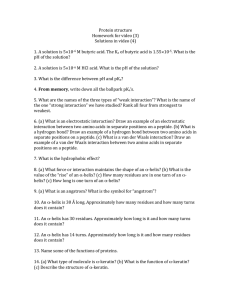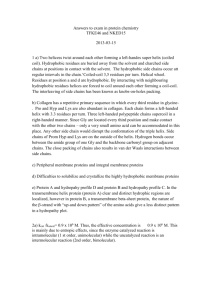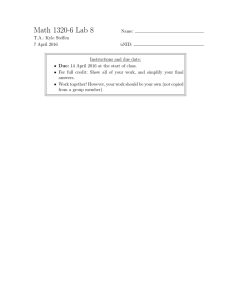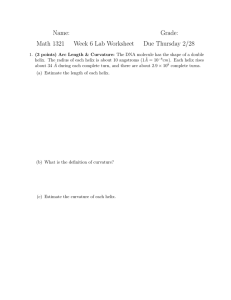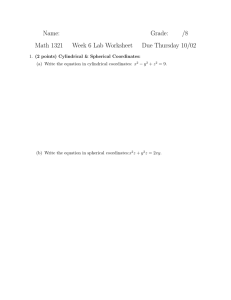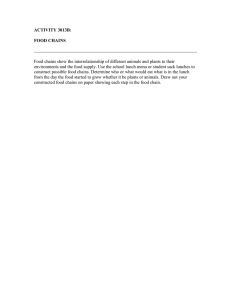Chapter 4 Protein 3-Dimensional Structure and Function
advertisement
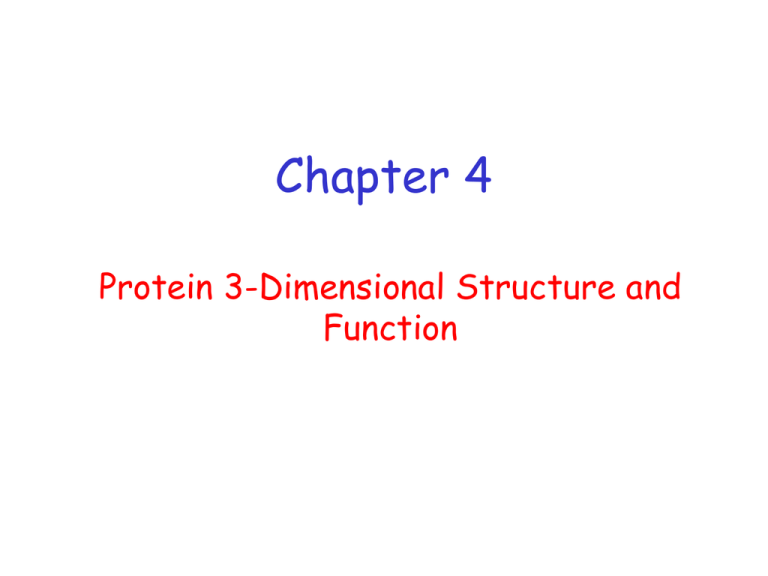
Chapter 4 Protein 3-Dimensional Structure and Function Terminology • Conformation – spatial arrangement of atoms in a protein • Native conformation – conformation of functional protein Protein Classification • Simple – composed only of amino acid residues • Conjugated – contain prosthetic groups (metal ions, co-factors, lipids, carbohydrates) Example: Hemoglobin – Heme Protein Classification • • • • One polypeptide chain - monomeric protein More than one - multimeric protein Homomultimer - one kind of chain Heteromultimer - two or more different chains (e.g. Hemoglobin is a heterotetramer. It has two alpha chains and two beta chains.) Protein Classification Fibrous – 1) 2) 3) 4) polypeptides arranged in long strands or sheets water insoluble (lots of hydrophobic AA’s) strong but flexible Structural (keratin, collagen) Globular 1) 2) 3) 4) – polypeptide chains folded into spherical or globular form water soluble contain several types of secondary structure diverse functions (enzymes, regulatory proteins) catalase keratin collagen Protein Function • • • • • • • • • Catalysis – enzymes Structural – keratin Transport – hemoglobin Trans-membrane transport – Na+/K+ ATPases Toxins – rattle snake venom, ricin Contractile function – actin, myosin Hormones – insulin Storage Proteins – seeds and eggs Defensive proteins – antibodies 4 Levels of Protein Structure Non-covalent forces important in determining protein structure • • • • van der Waals: 0.4 - 4 kJ/mol hydrogen bonds: 12-30 kJ/mol ionic bonds: 20 kJ/mol hydrophobic interactions: <40 kJ/mol 1o Structure Determines 2o, 3o, 4o Structure • Sickle Cell Anemia – single amino acid change in hemoglobin related to disease • Osteoarthritis – single amino acid change in collagen protein causes joint damage Classes of • Alpha helix • B-sheet • Loops and turns o 2 Structure 2o Structure Related to Peptide Backbone •Double bond nature of peptide bond cause planar geometry •Free rotation at N - aC and aCcarbonyl C bonds •Angle about the C(alpha)-N bond is denoted phi (f) •Angle about the C(alpha)-C bond is denoted psi (y) •The entire path of the peptide backbone is known if all phi and psi angles are specified Not all f/y angles are possible Ramachandran Plots •Describes acceptable f/y angles for individual AA’s in a polypeptide chain. •Helps determine what types of 2o structure are present Alpha-Helix • First proposed by Linus Pauling and Robert Corey in 1951 • Identified in keratin by Max Perutz • A ubiquitous component of proteins • Stabilized by H-bonds Alpha-Helix •Residues per Right handed turn: 3.6 helix •Rise per residue: 1.5 Angstroms •Rise per turn (pitch): 3.6 x 1.5A = 5.4 Angstroms •amino hydrogen H-bonds with carbonyl oxygen located 4 AA’s away forms 13 atom loop Alpha-Helix All H-bonds in the alpha-helix are oriented in the same direction giving the helix a dipole with the Nterminus being positive and the C-terminus being negative Alpha-Helix •Side chain groups point outwards from the helix •AA’s with bulky side chains less common in alpha-helix •Glycine and proline destabilizes alphahelix Amphipathic Alpha-Helices + One side of the helix (dark) has mostly hydrophobic AA’s Two amphipathic helices can associate through hydrophobic interactions Beta-Strands and Beta-Sheets • Also first postulated by Pauling and Corey, 1951 • Strands may be parallel or antiparallel • Rise per residue: • – 3.47 Angstroms for antiparallel strands – 3.25 Angstroms for parallel strands – Each strand of a beta sheet may be pictured as a helix with two residues per turn Beta-Sheets • Beta-sheets formed from multiple side-byside beta-strands. • Can be in parallel or anti-parallel configuration • Anti-parallel betasheets more stable Beta-Sheets • Side chains point alternately above and below the plane of the beta-sheet • 2- to 15 beta-strands/beta-sheet • Each strand made of ~ 6 amino acids Loops and turns Loops • Loops usually contain hydrophillic residues. • Found on surfaces of proteins • Connect alpha-helices and beta-sheets Turns • Loops with < 5 AA’s are called turns • Beta-turns are common Beta-turns • allows the peptide chain to reverse direction • carbonyl C of one residue is H-bonded to the amide proton of a residue three residues away • proline and glycine are prevalent in beta turns
